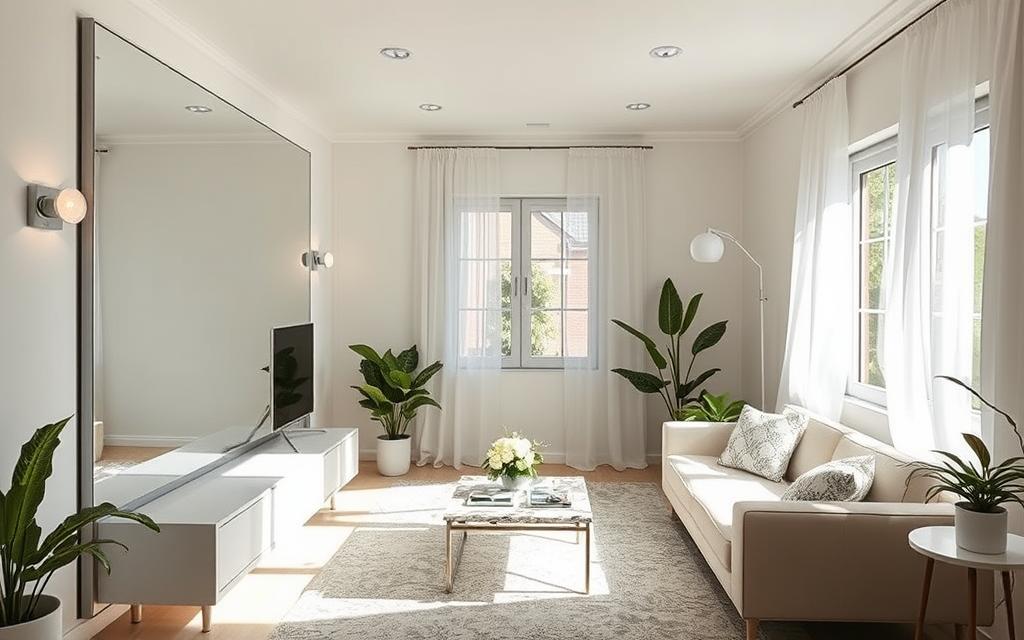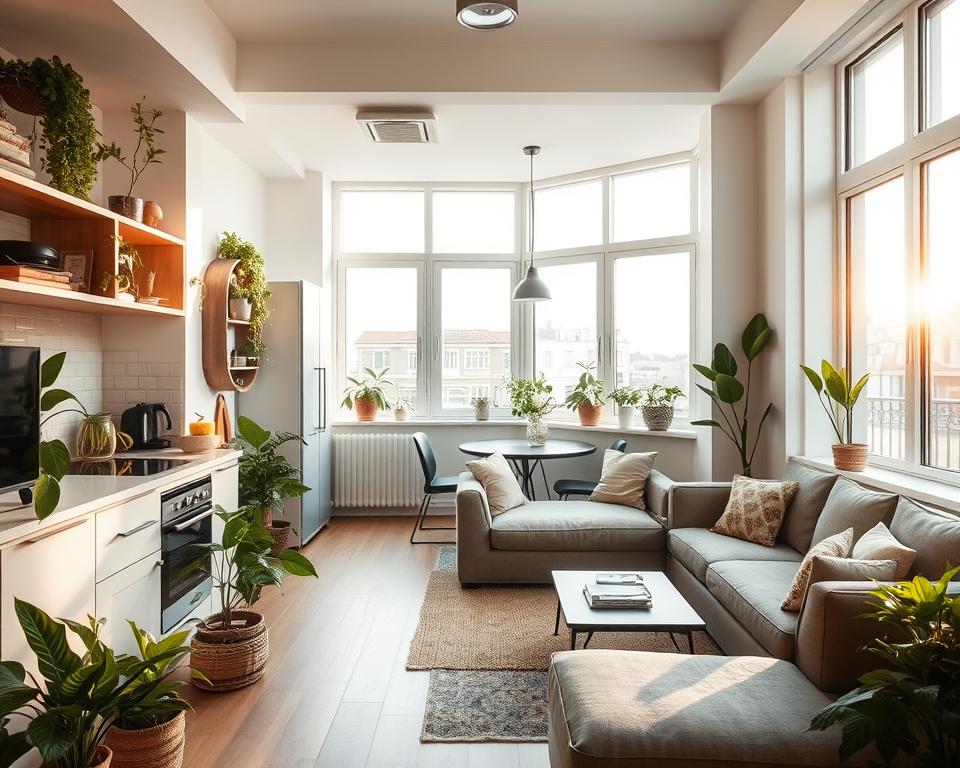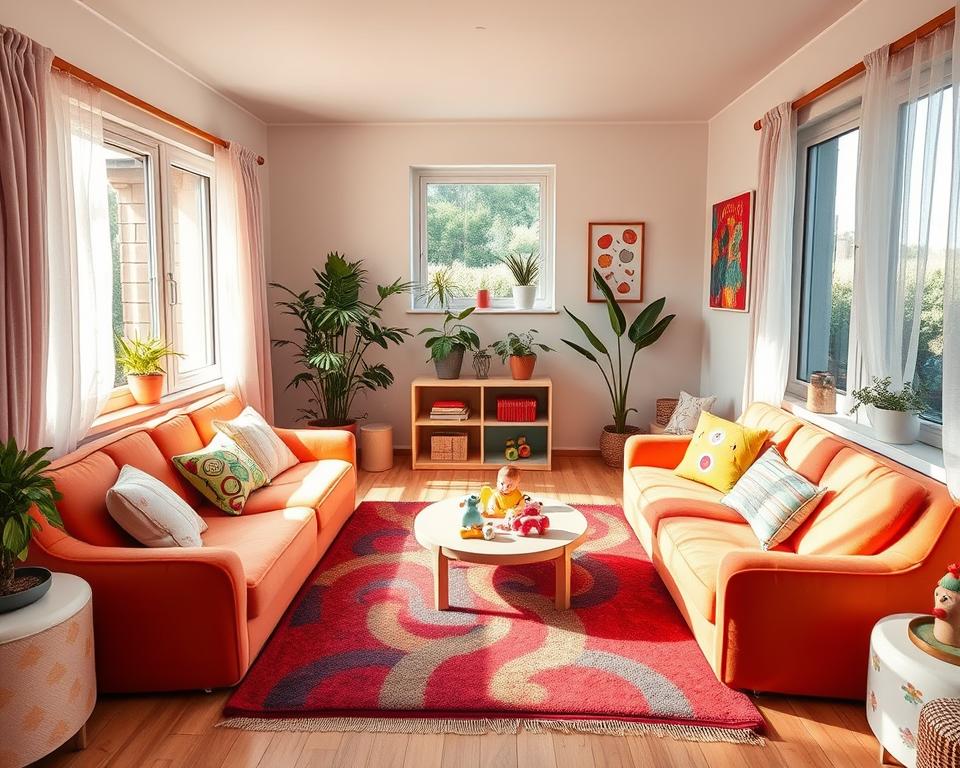Did you know 70% of homeowners wish they had more space? But, what if colors could help? Using the right colors can make a room feel bigger. It’s all about using color tricks for small spaces.
By choosing lighter paint colors and neutral palettes, you can make a room look larger. This is a key small space design tip. It helps create the illusion of a bigger space.
Lighter paint colors, like off-whites and pale blues, make rooms feel larger. Using one paint color can also improve a space’s look. By using color tricks, like minimalist window treatments and mirrors, you can make a small room feel bigger.
This makes your small room feel more comfortable and welcoming. It’s all about using smart small space design tips and color tricks.
Understand the Psychology of Color in Small Spaces
Designing small spaces involves choosing the right color palette for small rooms. The right room colors for small areas can make a room feel bigger. Dark colors make a room feel smaller, while light colors make it seem larger.
A good color palette for small rooms can make a space feel open and welcoming. Light colors on walls and ceilings reflect light, making a room feel bigger. Dark colors, however, can make a space feel cozy and intimate.
When picking room colors for small areas, consider the natural light, the room’s purpose, and the mood you want. A light, airy, and reflective color palette for small rooms can make a space feel spacious. This makes the most of small spaces.
Understanding color psychology is also key when choosing room colors for small areas. Cool colors like blues and greens can bring calmness. Warm colors like oranges and yellows can boost energy. By picking a color palette for small rooms that considers color psychology, you can create a space that’s both functional and beautiful.
The Power of Light Colors in Space Enhancement
Light colors are key in making small spaces look bigger. Using light colors in your design can make a room feel airy and open. Colors like off-white, clean white, and pale blues reflect light, making the space seem larger.
Pale blues are great for small spaces because they add a gentle feel. Off-white paint can make a room feel welcoming and bigger, especially with greenery and bright colors. Clean white paint brings calm and coziness, especially with wooden floors and bright decor.
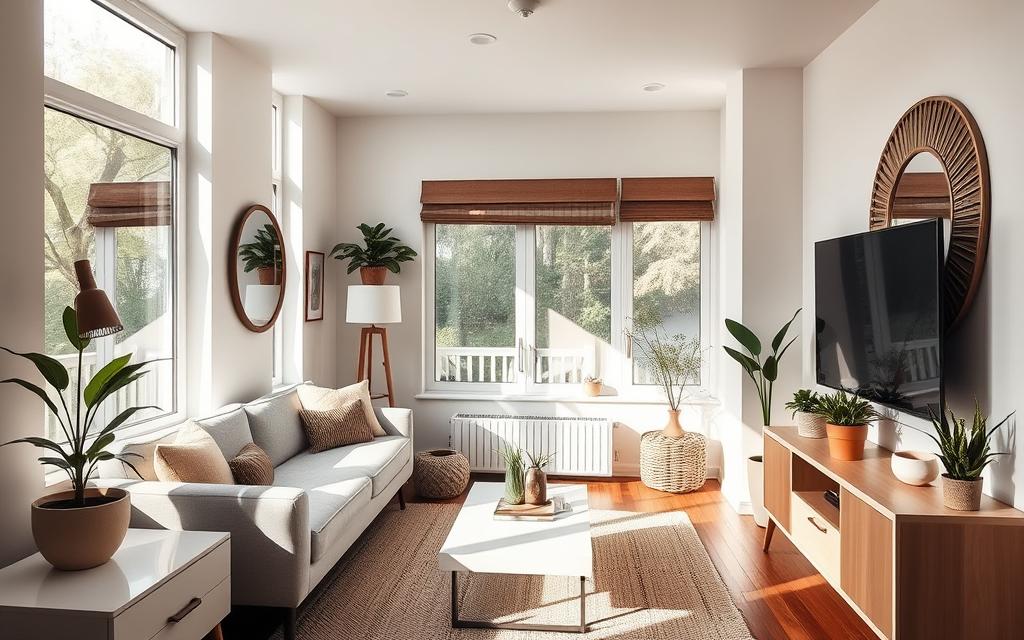
Light colors on walls, ceilings, and floors help make a room feel bigger. They also reflect light, making the room brighter. This is very helpful in small spaces with little natural light. By using light colors, you can make your room feel larger and more inviting.
Some popular light colors for small spaces include:
- Pale blues
- Off-white
- Clean white
- Light green
- Sea green
These colors work well on walls, ceilings, and floors. They help create a sense of continuity and make the room feel more spacious. Choosing the right light colors can make your small space feel more open and larger.
Proven Color Tricks for Small Spaces That Transform Rooms
Choosing the right colors for small rooms can make a big difference. Using a single color palette can make a room feel bigger and more open. This method helps create a sense of continuity and flow.
Creating a focal point with a bold color can also help. It draws the eye away from the room’s small size. Using mirrors to reflect light is another trick. It makes the room appear larger. Also, using bright colors on surfaces can reflect light and make the space feel bigger.
Some great color combinations for small rooms include plaster pink with deep charcoal accents. This mix creates a soothing yet modern look. Bold jewel tones like red and pink or green and blue add contrast and interest. Here are some tips to keep in mind:
- Use light and neutral colors to reflect more light and make the space feel airy and open.
- Opt for furniture that fits the scale of the room and multi-functional pieces to reduce the feeling of a cramped space.
- Use transparent materials like glass or acrylic in furniture to create an open and less crowded appearance.
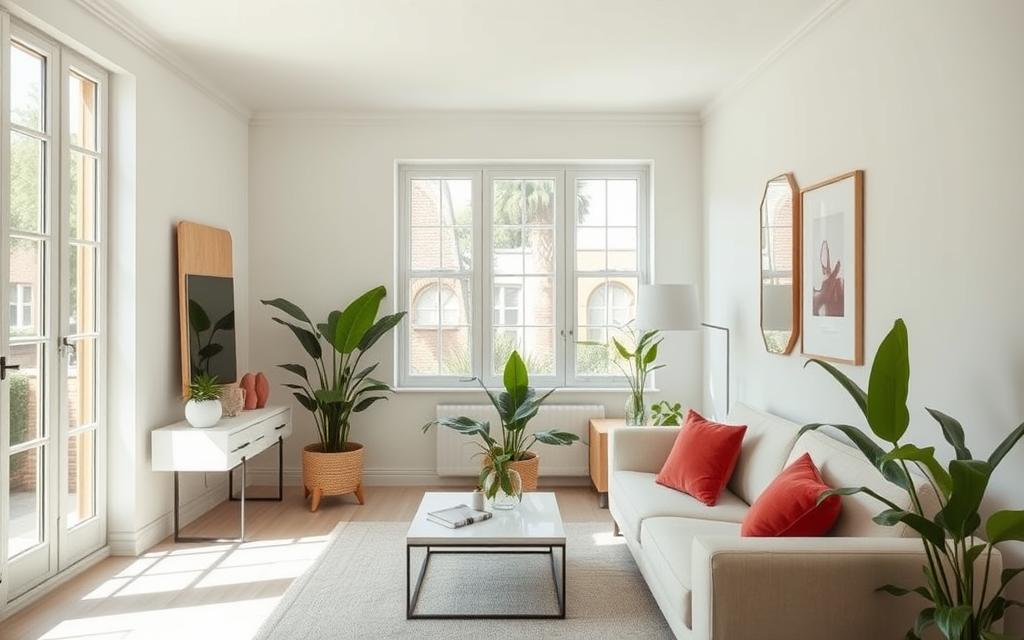
By using these clever color choices for compact rooms and color tricks for small spaces, you can turn a small room into a spacious and welcoming area.
Strategic Color Placement for Maximum Impact
Maximizing space with color is key in small spaces. Using color to create continuity makes rooms feel bigger and more welcoming. A monochromatic color scheme, with different shades of one color, works well. It brings a sense of flow and harmony, making the space appear larger.
Think about the room’s natural light when choosing colors. Light colors like pale blues, soft grays, or creamy whites can make a room feel bigger. Mirrors also help by reflecting light and creating depth, making the space seem more open.
Other tips include using furniture that serves more than one purpose, like ottomans with storage. Creating zones for different activities with rugs, furniture, or partitions also helps. By using these strategies and understanding color psychology, you can make a small space feel larger and more inviting.
- Use a monochromatic color scheme to create a sense of flow and visual harmony
- Consider the natural light available in the room when choosing colors
- Use mirrors to reflect light and create an illusion of depth
- Incorporate multi-functional furniture to maximize space
- Create distinct zones for different activities to create a sense of flow and functionality
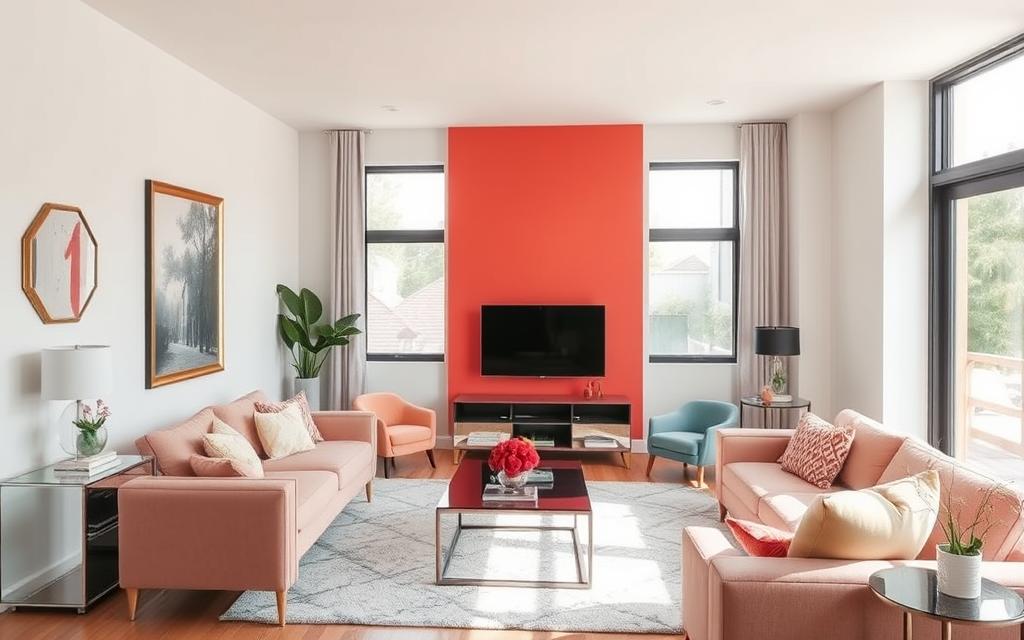
Strategic color placement is a powerful tool in interior design that can transform the perception of space, highlight architectural features, and create focal points. When used thoughtfully, color can influence mood, direct attention, and even alter the apparent proportions of a room. Here’s how to use strategic color placement for maximum impact:
1. Accent Walls
- Why it works : An accent wall draws attention to a specific area of the room, creating visual interest without overwhelming the space.
- How to use it :
- Behind the Bed or Sofa : Paint the wall behind your bed or sofa in a bold or contrasting color to make it the focal point of the room. For example, a deep navy blue or emerald green accent wall can anchor the space while lighter walls keep the rest of the room feeling open.
- Fireplace Wall : If your room has a fireplace, painting the surrounding wall in a rich color like charcoal or terracotta can emphasize its importance as a central feature.
2. Ceiling Color
- Why it works : The ceiling is often overlooked, but painting it a different color can dramatically alter the perception of height and space.
- How to use it :
- Dark Ceilings for Cozy Spaces : In rooms with high ceilings, painting the ceiling a darker color (like navy or charcoal) can make the space feel cozier and more intimate.
- Light Ceilings for Height : In smaller rooms or spaces with low ceilings, painting the ceiling white or a light color (like pale gray or soft blue) can make it appear taller and more expansive.
- Contrasting Trim : Adding a contrasting color to the ceiling trim (e.g., white trim on a dark ceiling) can further enhance the architectural details.
3. Color in Small Spaces
- Why it works : Contrary to popular belief, small spaces don’t always need to be painted in light colors. Strategic use of color can make compact areas feel intentional and stylish.
- How to use it :
- Bold Colors in Powder Rooms : Small bathrooms or powder rooms can handle bold colors like deep green, black, or burgundy because they are typically used for short periods. The intensity of the color can make the space feel luxurious and memorable.
- Vertical Stripes in Hallways : In narrow hallways, vertical stripes painted on the walls can draw the eye upward, making the space feel taller and less cramped.
4. Highlighting Architectural Features
- Why it works : Using color to emphasize architectural details like moldings, beams, or built-in shelving can add depth and character to a room.
- How to use it :
- Contrasting Trim : Painting crown molding, baseboards, or window frames in a contrasting color (e.g., white trim against navy walls) can make these features stand out and add elegance.
- Exposed Beams : If your room has exposed wooden beams, consider painting them a darker color (like black or espresso) to create a striking contrast against lighter walls.
- Built-In Shelves : Paint the back of bookshelves or cabinets a bold color (like teal or mustard yellow) to make them pop and draw attention to the items displayed.
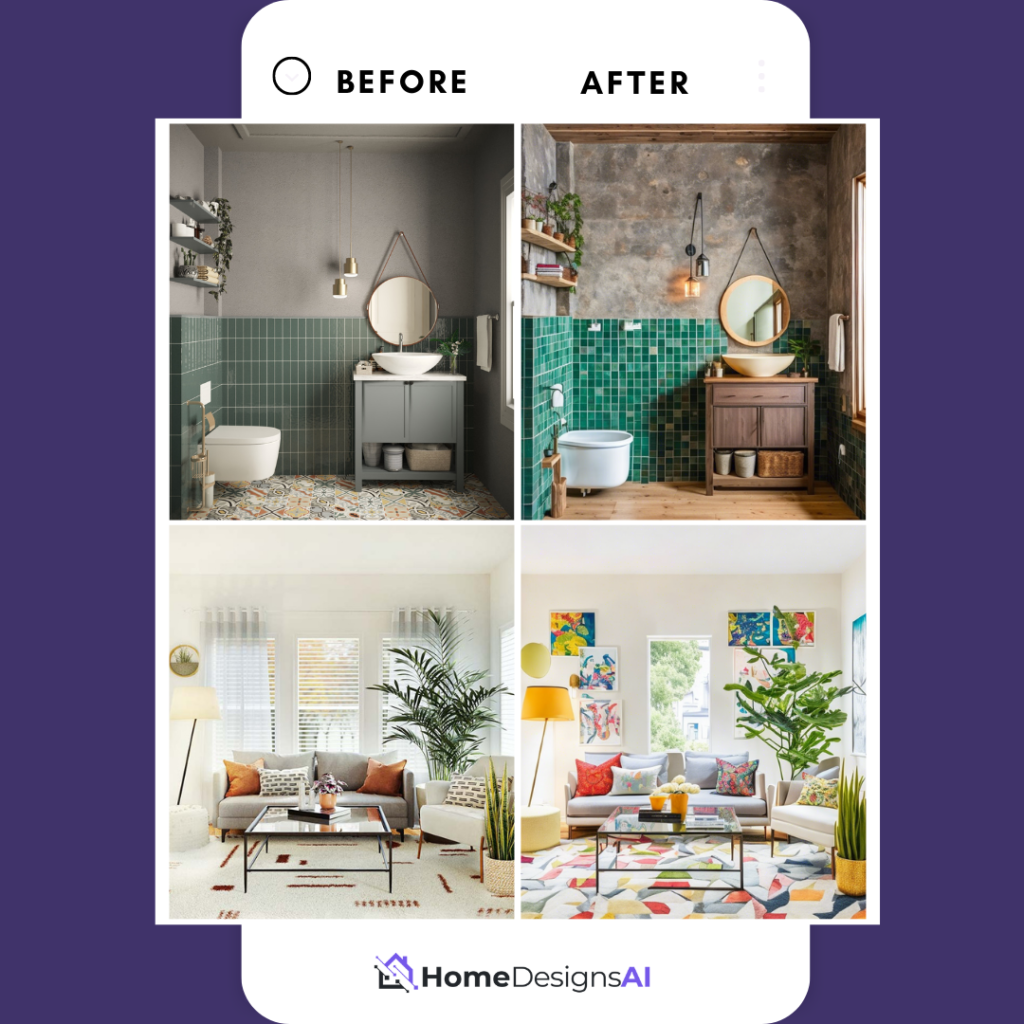
5. Color Flow Between Rooms
- Why it works : A cohesive color palette throughout your home creates a sense of flow and continuity, making the space feel larger and more harmonious.
- How to use it :
- Neutral Transitions : Use neutral colors (like white, beige, or gray) in hallways or transitional spaces to connect rooms with different color schemes.
- Complementary Colors : Choose complementary colors for adjacent rooms to create a natural progression. For example, if one room is painted in soft blue, the next could feature a warm beige or sandy tone.
- Monochromatic Flow : Use varying shades of the same color family in different rooms to create a seamless transition. For instance, a pale gray living room could flow into a slightly darker gray dining room.
6. Color in Nooks and Crannies
- Why it works : Often-overlooked spaces like alcoves, niches, or under-stair areas can become standout features with the right color treatment.
- How to use it :
- Bold Colors in Alcoves : Paint an alcove or niche a bold color (like cobalt blue or emerald green) to turn it into a striking focal point. This works especially well in minimalist spaces where the rest of the walls are neutral.
- Under-Stair Storage : If you have storage or seating under the stairs, paint the area a bright or unexpected color (like coral or mustard) to make it feel intentional and fun.
7. Color on Furniture
- Why it works : Painting furniture in bold or contrasting colors can add personality and prevent the room from feeling too monotonous.
- How to use it :
- Colorful Cabinets or Bookshelves : Paint kitchen cabinets, built-in bookshelves, or sideboards in a bold color (like navy, forest green, or blush pink) to make them stand out against neutral walls.
- Accent Chairs : Use brightly colored accent chairs (like mustard yellow or teal) to inject energy into a neutral room without overwhelming the space.
8. Color in Flooring
- Why it works : Flooring is a large surface area, and its color can significantly impact the overall feel of a room.
- How to use it :
- Light Floors for Brightness : Light-colored floors (like blonde wood or white tile) reflect light and make the room feel more open and airy.
- Dark Floors for Contrast : Dark floors (like ebony wood or charcoal tile) can ground a room and provide a striking contrast against light walls, adding depth and sophistication.
- Patterned Rugs : Use patterned rugs to define specific areas within a room (like a seating area in a living room) and add visual interest without committing to permanent changes.
9. Color in Lighting Fixtures
- Why it works : Lighting fixtures can serve as both functional and decorative elements, and their color can enhance the overall aesthetic.
- How to use it :
- Metallic Finishes : Choose lighting fixtures with metallic finishes (like brass, copper, or chrome) to add a touch of glamour and reflect light around the room.
- Colored Lampshades : Use lampshades in bold colors (like cobalt blue or emerald green) to introduce subtle pops of color in a neutral room.
10. Color in Unexpected Places
- Why it works : Adding color to unexpected areas can create surprise and delight, making the space feel more dynamic.
- How to use it :
- Inside Cabinets : Paint the inside of glass-front cabinets or shelves a bold color (like turquoise or magenta) to add a hidden pop of color that’s revealed when the doors are open.
- Back of Doors : Paint the back of doors a fun or unexpected color (like lime green or hot pink) to add a playful touch that’s only visible when the door is open.
- Window Frames : Paint the interior window frames a contrasting color (like black or navy) to frame the view and add architectural interest.
Strategic color placement is about more than just picking a paint color—it’s about understanding how color interacts with light, space, and architecture to create the desired effect. By focusing on key areas like accent walls, ceilings, architectural details, and unexpected nooks, you can maximize the impact of color in your home. Whether you’re aiming to create a focal point, enhance spatial perception, or add personality, thoughtful color placement can elevate your interior design to the next level.
Use Monochromatic Schemes to Create Depth
Monochromatic schemes are great for small rooms. They use different shades of the same color to add texture and interest. This makes small rooms feel more welcoming and calm.
A monochromatic color scheme blends similar colors to create depth without feeling too busy. Sue Wadden from Sherwin-Williams says it can make rooms look bigger, especially with darker colors. It’s important to use various shades and tones of the main color.
Designing a monochromatic room starts with a paint color that inspires the whole design. Laura Bohn from New York recommends starting with the lightest shade for beginners. Using black can also help ground the space and keep it unified.
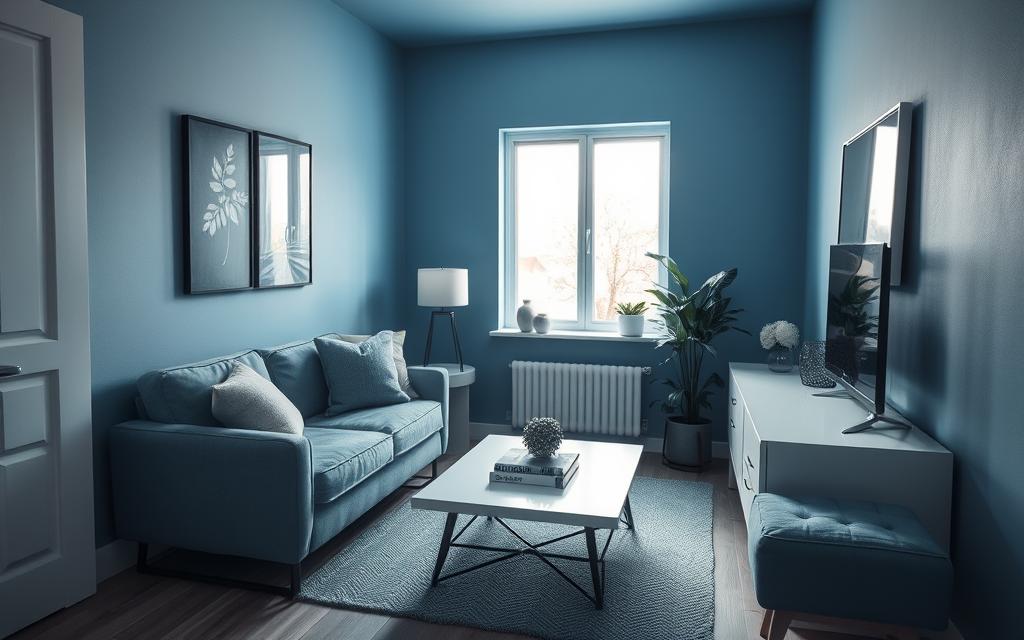
By following these tips, you can make a small room feel bigger and more inviting. Remember, the right color palette can add depth and cohesion. Don’t be afraid to try different shades and tones to find the perfect look for your space.
Color Combinations That Make Rooms Feel Spacious
Choosing the right colors is key for tiny spaces. A smart color scheme can make a room look bigger. You can pair light colors with bold ones, use neutral colors with pops of color, or stick to one color.
Neutral tones like greige, beiges, and soft whites bring calm to small areas. Vibrant shades like purple and electric red add color without feeling too much. Designers like Katie Davis and Megan Molten use colors like Lead Gray and Chantilly Lace for a clean, airy look.
Here are some tips for a space-saving color scheme:
- Use a single color palette to create a sense of continuity
- Pair light colors with bold colors to add depth and interest
- Use neutral colors with pops of color to create a sense of calmness and serenity

When designing a room, color plays a crucial role in influencing how spacious or confined the space feels. The right color combinations can create an illusion of openness, making even smaller rooms feel more expansive and airy. Here are some key color strategies and combinations that can help achieve this effect:
1. Light Neutral Tones
- Why it works : Light neutral colors like whites, creams, beiges, and soft grays reflect more light, which enhances the sense of space and openness.
- Combinations :
- White + Beige : A classic combination where white walls paired with beige furniture or accents create a calm, airy atmosphere.
- Cream + Soft Gray : Creamy walls with gray upholstery or rugs add depth without overwhelming the senses, maintaining a sense of openness.
2. Monochromatic Schemes
- Why it works : Monochromatic color schemes use variations of a single hue, creating a seamless flow that reduces visual clutter and makes the room feel larger.
- Combinations :
- Shades of Blue : From pale sky blue to deeper navy accents, this scheme creates a serene, continuous look that expands the perception of space.
- Tonal Whites : Different shades of white (e.g., ivory, pearl, off-white) can add subtle dimension while keeping the room feeling open and bright.
3. Cool Colors
- Why it works : Cool colors like blues, greens, and lavenders recede visually, giving the impression of more space. They also evoke a calming, refreshing atmosphere.
- Combinations :
- Pale Blue + White : This combination is perfect for bedrooms or bathrooms, offering a clean, tranquil vibe that enhances spatial perception.
- Mint Green + Soft Gray : Mint green walls paired with gray furniture or textiles create a fresh, modern look that feels open and inviting.
4. Contrasting Light and Dark Elements
- Why it works : While lighter colors expand space, adding small touches of darker tones can provide contrast and prevent the room from feeling too sterile or flat.
- Combinations :
- White Walls + Dark Wood Furniture : The contrast between light walls and rich wood tones adds depth and interest without closing in the space.
- Beige Walls + Navy Accents : Beige provides a light backdrop, while navy pillows, rugs, or curtains introduce a sophisticated touch without overwhelming the room.

5. Vertical Stripes
- Why it works : Vertical stripes draw the eye upward, making ceilings appear higher and the room feel taller.
- Combinations :
- White + Light Gray Striped Walls : Subtle vertical stripes in neutral tones elongate the walls without being too bold.
- Soft Blue + White Striped Curtains : Striped curtains can create the illusion of height when hung close to the ceiling.
6. Mirrors and Reflective Surfaces
- Why it works : Mirrors and reflective surfaces amplify light and visually double the space, enhancing the effect of any color combination.
- Combinations :
- White Walls + Mirrored Furniture : A white room with mirrored nightstands or side tables reflects light and creates the illusion of more space.
- Light Gray Walls + Chrome Accents : Chrome or metallic finishes on lighting fixtures or furniture legs can bounce light around the room, making it feel brighter and larger.
7. Pastel Color Palettes
- Why it works : Pastels are soft and light, making them ideal for creating a gentle, expansive atmosphere. They are less intense than bold colors, so they don’t overwhelm the senses.
- Combinations :
- Blush Pink + Pale Gray : This combination is perfect for living rooms or bedrooms, offering a soft, feminine touch while maintaining a sense of openness.
- Lavender + White : Lavender walls with white trim or furniture create a soothing, airy environment that feels larger than it is.
8. Minimalist Approach with Pops of Color
- Why it works : A minimalist approach with a predominantly light color palette allows you to introduce small pops of color without overwhelming the space. This keeps the room feeling open while adding personality.
- Combinations :
- White Walls + Yellow Accents : White walls with yellow throw pillows or artwork add warmth and energy without closing in the space.
- Beige Walls + Teal Accessories : Beige provides a neutral base, while teal vases, cushions, or rugs introduce a vibrant yet controlled accent.
9. Use of Textures
- Why it works : Incorporating different textures within a light color scheme adds depth and interest without detracting from the sense of space.
- Combinations :
- White Walls + Textured Rugs : A white room with a textured rug (like jute or wool) adds warmth and dimension without making the room feel smaller.
- Soft Gray Walls + Velvet Upholstery : Gray walls paired with velvet furniture in a complementary shade introduces tactile interest while maintaining an open feel.
10. Ceiling Color
Pale Gray Walls + White Ceiling : This combination keeps the focus on the height of the room, drawing the eye upward.
Why it works : Painting the ceiling a lighter color than the walls can make the room feel taller and more spacious.
Combinations :
White Ceiling + Light Blue Walls : A white ceiling with light blue walls creates a sky-like effect, making the room feel more open and airy.
To make a room feel more spacious, the key is to use light, cool, and neutral colors that reflect light and create a sense of continuity. However, incorporating small contrasts, textures, and strategic pops of color can prevent the space from feeling too monotonous or sterile. By carefully balancing these elements, you can design a room that feels both open and inviting, regardless of its actual size.
The Role of Contrast in Spatial Perception
Clever color choices are key to making small rooms look bigger. Using contrast can add depth and layering, making spaces feel more open. For example, painting the back wall and ceiling darker, while leaving side walls lighter, can widen a room’s feel.
Most of our lives are spent indoors, making our living spaces important. Contrast, like mixing light and dark shades, can make rooms appear taller or wider. Painting the ceiling lighter than the walls can make ceilings seem higher. Darker shades on side walls can make a room feel narrower.

Effective color tricks include using light colors on backgrounds and ceilings, and dark colors on side walls. This makes a space feel more open and fresh. Warm colors like yellow and orange in kitchens can boost appetite. Cool green touches can balance warmth and add freshness. These tricks help make small spaces feel more welcoming and spacious.
When using contrast, remember:
- Light colors make spaces feel open and airy.
- Darker colors add coziness and intimacy.
- Warm and cool colors spark conversation and creativity.
- Try different color mixes for a cohesive, comfy space.
Incorporate Natural Colors for Openness
Maximizing space with color is key in small spaces. Natural colors like earthy tones and blues make small rooms feel open. These colors bring a sense of calm and invite you in.
Using earthy tones for walls and floors is a good start. Add blues and greens with accessories to balance the space. Natural materials like wood and stone add warmth and coziness.

The 60-30-10 rule helps with color in small spaces. It means 60% of the room is a main color, 30% a secondary, and 10% an accent. This balance makes the space feel open and airy. Shades of green and blue are popular for their calming effect.
- Use earthy tones for walls and floors to create a sense of balance and harmony
- Add blues and greens through accessories and decorative objects to create a sense of calmness and serenity
- Use natural materials, such as wood and stone, to add warmth and texture to the space
By using natural colors and the 60-30-10 rule, you can make your small space feel open and welcoming. Remember, small space design tips like these help create a balanced and harmonious space.
Common Color Mistakes to Avoid in Small Spaces
Choosing the right color palette for small rooms is key. Using too many bold colors can overwhelm a small space. It’s essential to consider the natural light in the room and choose colors that complement it.
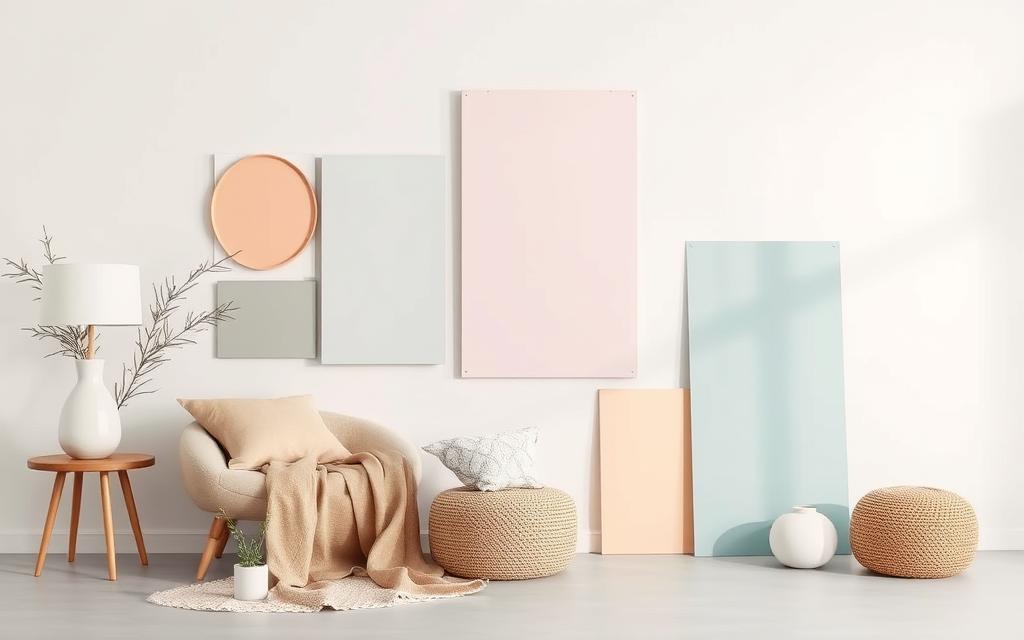
Avoid dark colors on walls and furniture to keep small rooms feeling open. Lighter colors reflect light, making the space feel larger.
Other common mistakes include:
- Not using a single color palette throughout the room
- Not considering the color of furniture and decor
- Using too many patterns and textures
By avoiding these mistakes, you can create a harmonious and inviting color scheme. This will make your small room feel larger and more welcoming.
Interior designers suggest choosing a few key pieces and leaving breathing room in small spaces. Opting for lighter colors on walls and furniture helps create a sense of openness.

Color Tricks for Small Spaces
Decorating small spaces can be challenging, but the right color tricks for small spaces can transform a cramped room into an open, airy sanctuary. Whether you’re working with a tiny apartment, a cozy bedroom, or a small home office, strategic use of color can create the illusion of space. Let’s explore some simple yet effective color tricks that can make your small spaces feel bigger, brighter, and more inviting.
. Embrace Light and Neutral Colors
Light colors, like whites, creams, soft greys, and pastels, are your best friend when working with small spaces. They reflect natural light, making a room appear larger and more open. For example:
- White walls: A classic choice that creates a blank canvas, amplifying natural light.
- Pastel tones: Soft blues, pale yellows, or blush pinks add personality without overwhelming the space.
2. Use Monochromatic Color Schemes
Stick to a single color palette with varying shades and tones. This technique reduces visual clutter and creates a seamless, flowing effect that tricks the eye into perceiving more space. For instance:
- Pair light grey walls with charcoal accents.
- Use varying shades of beige for a warm, cohesive look.
3. Add a Pop of Color to Accentuate Depth
Introduce bold, vibrant colors in small doses to add depth and character to your room. This works well with:
- An accent wall in a rich hue like navy blue or forest green.
- Bright-colored throw pillows, rugs, or artwork to draw attention without overwhelming the space.
4. Go for Cool Tones
Cool tones like light blue, mint green, or soft lavender can make a room feel calm and expansive. These colors visually recede, giving the impression of more space. Use them on walls, ceilings, or large furniture pieces to create a serene and open ambiance.
5. Paint Ceilings a Lighter Color
A lighter ceiling color draws the eye upward, creating the illusion of height. If you want an even more dramatic effect, use a glossy paint finish to reflect light and make the ceiling appear even higher.
6. Create Contrast Strategically
Contrasting colors can make specific elements stand out, adding dimension to the room. For example:
- Paint your trim or molding in a slightly darker shade than your walls for subtle depth.
- Use contrasting furniture and decor to highlight key areas without overpowering the space.
7. Incorporate Stripes or Patterns
Stripes, whether on rugs or walls, can elongate or widen a room depending on their orientation:
- Vertical stripes add height.
- Horizontal stripes make a room appear wider.
Stick to subtle, soft-toned patterns to maintain an open, uncluttered feel.
8. Use Mirrors to Amplify Light and Space
While technically not a color trick, mirrors reflect both light and color, effectively doubling the perceived size of your space. Position mirrors opposite windows to maximize natural light or use mirrored furniture for an ultra-modern, spacious vibe.
9. Limit the Number of Colors
Too many colors in one small space can feel chaotic and cramped. Instead, follow the 60-30-10 rule:
- 60% of the room in a dominant color (walls).
- 30% in a secondary color (furniture).
- 10% in an accent color (decor or accessories).
10. Use Transparent or Reflective Furniture
Acrylic, glass, or metallic furniture reflects light and blends seamlessly into the surroundings, reducing visual clutter and making the room feel bigger.
By applying these color tricks for small spaces, you can create an illusion of spaciousness without any major renovations. From embracing light neutrals to strategically using mirrors and cool tones, these tips will make your cozy space feel like a luxurious retreat. Ready to transform your small room into an airy haven? Start with a splash of paint and watch the magic happen!
Implementing Your Color Strategy
Learning the right color strategy can change how small spaces feel and work. By knowing how colors affect us, using light colors, and avoiding mistakes, you can make any room feel welcoming. Start with a color scheme and add pops of color and contrast to make it feel bigger.
Choose a color scheme that works for you, whether it’s one color or a mix. Think about the natural light in your space and pick finishes that make it brighter. With creativity and care, even the smallest areas can become bright and beautiful.

Source Links
- Make your small space feel bigger with these tips – https://urbanrhythm.com.au/blogs/urstyle/make-your-small-space-feel-bigger?srsltid=AfmBOooztxTm6aMPv6SFV58BtJa3L_vlPO_-AtMFLY4Id9PQDcP7PFDn
- 5 Colors That Make Rooms Look Bigger & Brighter – https://www.benjaminmoore.com/en-us/project-ideas-inspiration/interiors/make-small-room-look-bigger-brighter
- 37 Examples of Color Psychology on Room Interiors – https://maverickblueberry.com/blogs/interiors/psychology-of-colors-in-room-interiors
- The Interior Design Institute – https://www.theinteriordesigninstitute.com/us/en/blog-power-of-color-psychology-in-design
- How do colors in my home change my mood? Color psychology explained – https://mhanational.org/surroundings/color-psychology-explained
- The Interior Design Institute – https://www.theinteriordesigninstitute.com/au/en/blog-power-of-colour-psychology-in-design
- 10 Color Options That Will Make Small Rooms Look Bigger – https://www.romanza.com/blog/10-color-options-will-make-small-rooms-look-bigger
- The best color combinations for small rooms – 12 ways to bring character to compact spaces – https://www.homesandgardens.com/interior-design/color-combinations-for-small-rooms
- The Art Of Illusion: Make Small Spaces Look Larger – https://www.jennifergardnerdesign.com/home-renovation-blog/the-art-of-illusion-make-small-spaces-look-larger
- 20 Top Interior Color Schemes for Your House Design – Foyr Neo – https://foyr.com/learn/interior-color-schemes-for-house
- Interior Design Ideas for Tiny Homes – Charlotte, NC – https://artisticinteriordesign.com/maximizing-small-spaces-interior-design-ideas-for-tiny-homes/
- Monochromatic Colors: 9 Ways to Pull Off the Trend Like a Pro – https://www.architecturaldigest.com/story/monochromatic-room-design-tips
- Monochromatic Designs Are the Home Color Trend We Can’t Wait to Try – https://www.bhg.com/decorating/color/colors/monochromatic-color-trend/
- 12 Paint Colors That Will Make Small Rooms Feel Bigger – https://www.southernliving.com/paint-colors-for-small-rooms-6541524?srsltid=AfmBOooSgMghqRAFbAQysmQNmh8HcsaNhyZwquVjHHIRK-ZFwibruzRe
- These Paint Colors Can Make Small Spaces Appear Way Larger – https://www.housebeautiful.com/room-decorating/colors/g300/paint-small-rooms-0408/
- How Colors Change the Perception of Interior Spaces – https://www.archdaily.com/935067/how-colors-change-the-perception-of-interior-spaces
- The Interior Design Institute – https://www.theinteriordesigninstitute.com/ca/en/blog-power-of-colour-psychology-in-design
- How does color affect the perceived size of a room? – https://www.linkedin.com/advice/0/how-does-color-affect-perceived-size-room-interior-design-advice-dfhjf
- How to Incorporate Color in Small Spaces in Interior Design – https://www.linkedin.com/pulse/how-incorporate-color-small-spaces-interior-design-jack-william
- 27 Inspired-By-Nature Color Palettes for a Beautiful Home – https://www.bhg.com/decorating/color/schemes/nature-inspired-color-palettes-281474979472421/
- Maximizing Small Spaces with Color and Paint Techniques – https://www.paintingservicesingapore.com/articles/maximizing-small-spaces-with-color-and-paint-techniques.html
- 6 Small-Space Decorating Mistakes Everyone Makes, According to Designers – https://www.realsimple.com/mistakes-when-decorating-a-small-room-8643983
- 9 Décor Mistakes to Avoid in Small Spaces, According to Designers – https://www.marthastewart.com/decor-mistakes-small-spaces-8415415
- Color Strategy: How to Feel Confident Using Color in Your Home – https://aestheticsofjoy.com/a-simple-way-to-feel-more-confident-using-color-in-your-home/
- Maximizing Small Spaces: Color Strategies and Painting Tips for Compact Homes in Singapore – The Singaporean – https://thesingaporean.sg/maximizing-small-spaces-color-strategies-and-painting-tips-for-compact-homes-in-singapore/


